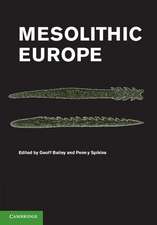From Foraging to Farming in the Andes: New Perspectives on Food Production and Social Organization
Editat de Tom D. Dillehayen Limba Engleză Paperback – 12 oct 2014
| Toate formatele și edițiile | Preț | Express |
|---|---|---|
| Paperback (1) | 365.23 lei 6-8 săpt. | |
| Cambridge University Press – 12 oct 2014 | 365.23 lei 6-8 săpt. | |
| Hardback (1) | 759.41 lei 6-8 săpt. | |
| Cambridge University Press – 13 feb 2011 | 759.41 lei 6-8 săpt. |
Preț: 365.23 lei
Nou
Puncte Express: 548
Preț estimativ în valută:
69.92€ • 71.91$ • 58.00£
69.92€ • 71.91$ • 58.00£
Carte tipărită la comandă
Livrare economică 19 februarie-05 martie
Preluare comenzi: 021 569.72.76
Specificații
ISBN-13: 9781107448667
ISBN-10: 1107448662
Pagini: 380
Ilustrații: 96 b/w illus. 4 colour illus. 15 maps 9 tables
Dimensiuni: 168 x 246 x 18 mm
Greutate: 0.86 kg
Editura: Cambridge University Press
Colecția Cambridge University Press
Locul publicării:New York, United States
ISBN-10: 1107448662
Pagini: 380
Ilustrații: 96 b/w illus. 4 colour illus. 15 maps 9 tables
Dimensiuni: 168 x 246 x 18 mm
Greutate: 0.86 kg
Editura: Cambridge University Press
Colecția Cambridge University Press
Locul publicării:New York, United States
Cuprins
Foreword Peter Kaulicke; 1. Introduction Tom D. Dillehay; 2. Research history, methods, and site types Tom D. Dillehay, Kary Stackelbeck, Jack Rossen and Greg Maggard; 3. Pleistocene and Holocene environments Patricia J. Netherly; 4. El Palto phase Greg Maggard and Tom D. Dillehay; 5. Las Pircas phase Jack Rossen; 6. Tierra Blanca phase Kary Stackelbeck and Tom D. Dillehay; 7. Preceramic mounds and hillside villages Tom D. Dillehay, Patricia J. Netherly and Jack Rossen; 8. Human remains John Verano and Jack Rossen; 9. Preceramic plant use Jack Rossen; 10. Faunal remains Kary Stackelbeck; 11. Material cultures Tom D. Dillehay, Greg Maggard, Jack Rossen and Kary Stackelbeck; 12. Forager and farming land use systems Tom D. Dillehay; 13. From foraging to farming and community development Tom D. Dillehay, Jack Rossen and Kary Stackelbeck; 14. Northern Peruvian early and middle preceramic agriculture in Central and South American context Dolores Piperno; 15. Conclusions Tom D. Dillehay; Appendix 1. Radiocarbon dates from the study area; Appendix 2. Dry forests and biomes of the coastal valleys and lower western slopes of northwestern Peru Patricia J. Netherly; Appendix 3. Stable carbon isotopes Patricia J. Netherly; Appendix 4. Faunal remains from all phases Kary Stackelbeck.
Recenzii
'… a seminal volume that will be referenced and discussed for decades … Essential for any anthropologist, archaeologist, or botanist, interested in the origins of New World agriculture or domestic plants, as well as for model-building in this issue worldwide.' David Browman, Choice
'[This book] brings us altogether closer to rooting our particular devil out of these emerging details. It will be required reading for those interested in the foundations of Andean civilisation, or indeed the origins of food production worldwide.' David Beresford-Jones, McDonald Institute for Archaeological Research, University of Cambridge
'[This book] brings us altogether closer to rooting our particular devil out of these emerging details. It will be required reading for those interested in the foundations of Andean civilisation, or indeed the origins of food production worldwide.' David Beresford-Jones, McDonald Institute for Archaeological Research, University of Cambridge
Descriere
This book proposes a new and more complex model for understanding the transition from hunting and gathering to cultivation.










